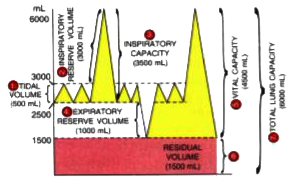During inspiration
Diaphragm and extemal intercostal muscles relax
Diaphragm and internal intercostal muscles relax
Diaphragm and external intercostal muscles contract
Diaphragm and internal intercostal muscles contract
The correct Answer is:C
Inspiration is initiated by the contraction of diaphragm which increases the volume of thoracic chamber in the anterior-posterior axis.
During inspiration diaphragm contract and become flat.
The contraction of external inter-coastal muscles lifts up the ribs and the sternum causing an increase in the volume of the thoracic chamber in the dorso-ventral axis. The overall increase in the thoracic volume causes a similar increase in pulmonary volume.
An increase in pulmonary volume decreases the intra pulmonary pressure to less than the atmospheric pressure which forces the air from outside to move into the lungs, i.e. inspiration.
Similar Questions
Which statements are correct ?
(A) During inspiration intra pulmonary pressure is less than the atmospheric pressure.
(B) During expiration diaphragm contract.
(C) Epiglottis is bony flap which prevent entry of food into the larynx.
(D) During forceful expiration abdominal muscles contract.
View SolutionThe volume of air in the lungs and the rate at which it is exchanged during inspiration and expiration was measured.
The following diagram shows a group of the lung volumes and capacities :

Study the diagram carefully and explain briefly the following:
(a) Tidal volume
(b) Inspiratory reserve volume
(c) Expiratory reserve volume
(d) Vital capacity
(e) Residual volume
View Solution
Knowledge Check
Which statements are correct ?
(A) During inspiration intra pulmonary pressure is less than the atmospheric pressure.
(B) During expiration diaphragm contract.
(C) Epiglottis is bony flap which prevent entry of food into the larynx.
(D) During forceful expiration abdominal muscles contract.AA, B, C, D are correctBA and D are correctCB and C are correctDA and C are correctAdditional volume of air a person can inspire by a forcible inspiration is called
AICBECCIRVDERVA: Normal expiration during quiet breathing, unlike
inspiration, is a passive process because on
muscular contractions are involved.
R: Normal expiration results from the elastic recoil
of the chest wall and lungs.AIf both Assertion & Reason are true and the
reason is the correct explanation of the
assertion, then mark (1)BIf both Assertion & Reason are trye but the
reason is not the correct explanation of the
assertion , then mark (2)CIf Assertion is true statement but Reason is
fakse, then mark (3)DIf both Assertion and Reason are false
statements, then mark (4)
How do the following contribute in inspiration during breathing? (i) Ribs (ii) Diaphragm
View SolutionA: Normal expiration during quiet breathing, unlike
inspiration, is a passive process because on
muscular contractions are involved.
R: Normal expiration results from the elastic recoil
of the chest wall and lungs.
View SolutionAn additional volume of air, a person can inspire by
a forceful inspiration is known as
View SolutionThe extra volume of air that can be inspired forcibly after normal inspiration is
View SolutionAn additional volume of air, a person can inspire by
a forceful inspiration is known as
View Solution
